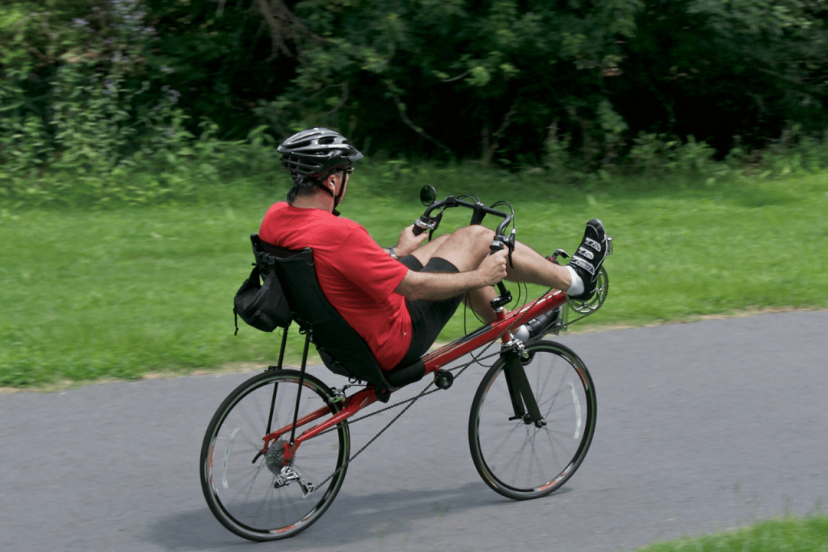Recumbent Bicycles for Rehabilitation: Enhancing Fitness and Recovery
Introduction
Rehabilitation and fitness play crucial roles in maintaining and improving our overall well-being. Whether you’re recovering from an injury, managing a chronic condition, or simply striving to stay fit, finding the right exercise equipment is essential. One such equipment that has gained popularity in recent years is the recumbent bicycle. In this article, we will explore the world of recumbent bicycles and how they can enhance both fitness and recovery. So, let’s dive in!
Understanding Recumbent Bicycles
What are Recumbent Bicycles?
Recumbent bicycles are a unique type of bike designed with a reclined seating position, where the rider’s feet are positioned in front of them. Unlike traditional upright bicycles, recumbent bicycles provide a more comfortable and ergonomic riding experience.
Types of Recumbent Bicycles
There are various types of recumbent bicycles available, each with its own design and features. Here are four common types:
-
Long Wheelbase Recumbent Bicycles:
– Features a longer frame, offering stability and a smooth ride.
– Suitable for leisurely rides and long-distance touring. -
Short Wheelbase Recumbent Bicycles:
– Compact design with a shorter frame and smaller wheelbase.
– Offers greater manoeuvrability and responsiveness. -
Tadpole Recumbent Bicycles:
– Three-wheeled recumbent bicycles with two wheels at the front.
– Provides excellent stability and is popular among riders with balance issues. -
Delta Recumbent Bicycles:
– Three-wheeled recumbent bicycles with two wheels at the back.
– Offers a more laid-back riding position and increased cargo capacity.
Benefits of Recumbent Bicycles for Rehabilitation
Recumbent bicycles have gained recognition for their effectiveness in rehabilitation settings. Let’s explore the specific benefits they offer:
-
Low Impact Exercise:
– Recumbent bicycles provide a low-impact cardiovascular workout, reducing stress on joints and minimizing the risk of injuries.
-
Enhanced Joint Support:
– The ergonomic design of recumbent bicycles helps distribute body weight evenly, reducing strain on the joints and supporting individuals with joint-related conditions.
-
Promotes Cardiovascular Health:
– Regular exercise on a recumbent bicycle improves heart health, strengthens the cardiovascular system, and increases endurance.
-
Builds Muscular Strength and Endurance:
– Pedaling against resistance on a recumbent bicycle engages the leg muscles, including quadriceps, hamstrings, and calves, helping build strength and endurance.
Recumbent Bicycles and Rehabilitation
Rehabilitation and Its Role in Recovery
Rehabilitation plays a crucial role in recovering from injuries or managing chronic conditions. It aims to restore functionality, improve mobility, and enhance overall quality of life. Exercise is a fundamental component of rehabilitation, and recumbent bicycles offer unique advantages in this context.
How Recumbent Bicycles Aid Rehabilitation
Recumbent bicycles are particularly beneficial for rehabilitation due to the following reasons:
-
Low Impact Exercise:
– Engaging in low impact exercise is crucial during rehabilitation to minimize stress on injured or healing areas.
– Recumbent bicycles provide a smooth and gentle workout that doesn’t place excessive strain on joints or muscles. -
Enhanced Joint Support:
– Recumbent bicycles offer excellent support for individuals with orthopedic conditions, such as knee or hip injuries.
– The reclined seating position reduces the load on weight-bearing joints, allowing for safe and effective exercise. -
Promotes Cardiovascular Health:
– Cardiovascular fitness is essential for overall health, including during the rehabilitation process.
– Recumbent bicycles provide a smooth cardiovascular workout, helping improve heart health, circulation, and endurance. -
Builds Muscular Strength and Endurance:
– Rehabilitation often involves rebuilding strength and endurance in injured or weakened muscles.
– Pedaling against resistance on a recumbent bicycle helps target and strengthen specific muscle groups, aiding in the recovery process.
Common Conditions and Injuries That Benefit from Recumbent Bicycles
Recumbent bicycles can be beneficial for a wide range of conditions and injuries. Here are some examples:
-
Orthopedic Injuries:
– Individuals recovering from knee, hip, or ankle injuries can benefit from the low-impact exercise provided by recumbent bicycles.
– The ergonomic design supports proper alignment and reduces stress on the injured areas. -
Cardiovascular Conditions:
– Recumbent bicycles offer a safe and effective option for individuals with cardiovascular conditions.
– The reclined position reduces the strain on the heart and allows for controlled exercise to improve cardiovascular health. -
Neurological Conditions:
– Individuals with neurological conditions, such as stroke or spinal cord injuries, can benefit from recumbent bicycles during rehabilitation.
– The seated position and controlled movements help improve coordination, balance, and muscle control. -
Chronic Pain Conditions:
– Recumbent bicycles can be suitable for individuals with chronic pain conditions, such as arthritis or fibromyalgia.
– The low-impact nature of the exercise helps reduce pain while still providing the benefits of cardiovascular exercise.
Fitness Benefits of Recumbent Bicycles
Low-Impact Cardiovascular Exercise
Recumbent bicycles provide an excellent option for cardiovascular exercise without the high impact associated with activities like running or traditional cycling. The seated position and reclined back support reduce stress on the joints, making it accessible for individuals with joint issues or those who prefer a gentler workout.
Lower Risk of Injuries
The design of recumbent bicycles minimizes the risk of common cycling-related injuries. The reclined position reduces strain on the neck, wrists, and lower back, which are often prone to discomfort or overuse in traditional cycling. This makes recumbent bicycles a suitable choice for individuals with pre-existing conditions or those recovering from injuries.
Engages Multiple Muscle Groups
While primarily targeting the lower body, recumbent bicycles engage various muscle groups, including the quadriceps, hamstrings, calves, and glutes. The pushing motion of the pedals activates these muscles, promoting strength, toning, and improved muscular endurance.
Improves Flexibility and Range of Motion
The seated position on a recumbent bicycle helps stretch and promote flexibility in the hips, which can be particularly beneficial for individuals with tight hip flexors or limited range of motion. Regular use of a recumbent bicycle can contribute to improved overall flexibility.
Weight Management and Calorie Burn
Recumbent bicycles offer an effective way to burn calories and manage weight. The continuous pedaling motion increases energy expenditure, making it an ideal exercise option for those aiming to lose weight or maintain a healthy weight.
How to Choose the Right Recumbent Bicycle
Considerations for Rehabilitation
-
Seat and Back Support:
– Look for a recumbent bicycle with a comfortable and supportive seat that provides proper lumbar support.
– Adjustable backrests are beneficial to accommodate varying levels of comfort and support needs. -
Adjustable Resistance:
– Choose a recumbent bicycle with adjustable resistance levels to cater to different stages of rehabilitation.
– Gradually increasing the resistance can help individuals progress and challenge their muscles as they regain strength. -
Step-Through Design:
– For individuals with mobility issues or limited flexibility, a recumbent bicycle with a step-through design makes mounting and dismounting easier and safer.
Factors to Consider for Fitness Goals
-
Bike Frame and Wheelbase:
– Consider the frame length and wheelbase based on your height, as well as the intended use of the bicycle.
– Longer wheelbases provide stability and comfort for longer rides, while shorter wheelbases offer agility and maneuverability. -
Comfort and Ergonomics:
– Look for features that enhance comfort, such as a padded seat, adjustable seat position, and ergonomic handlebars.
– Consider the overall fit and adjustability of the bike to ensure a comfortable riding experience. -
Resistance Levels and Programs:
– Choose a recumbent bicycle that offers a range of resistance levels to accommodate your fitness goals.
– Some models come with pre-set workout programs that add variety and challenge to your exercise routine.
Getting Started with Recumbent Bicycles for Rehabilitation
Consulting a Healthcare Professional
Before incorporating recumbent bicycles into your rehabilitation program, it’s essential to consult with a healthcare professional or a qualified exercise specialist. They can assess your specific needs, provide guidance on exercise intensity and duration, and ensure the exercises are safe and effective for your condition.
Setting Realistic Goals
Set realistic goals based on your current fitness level and rehabilitation needs. Establish both short-term and long-term goals to track your progress and stay motivated throughout the rehabilitation journey.
Creating a Personalized Exercise Plan
Work with a healthcare professional or an exercise specialist to develop a personalized exercise plan that incorporates recumbent cycling. The plan should consider your specific condition, limitations, and goals, as well as the recommended frequency and duration of exercise.
Proper Form and Technique
Learn and practice proper form and technique when using a recumbent bicycle. Maintain good posture, engage your core muscles, and focus on a smooth and controlled pedaling motion. Avoid straining or overexerting yourself during the exercise.
Progression and Monitoring
Gradually increase the intensity, duration, and resistance of your recumbent bicycle workouts as your fitness and strength improve. Regularly monitor your progress, reassess your goals, and make adjustments to your exercise plan accordingly.
Tips for Maximizing Recovery and Fitness with Recumbent Bicycles
Gradual Progression and Incremental Challenges
Progress gradually in your rehabilitation journey and fitness goals. Increase the duration or intensity of your workouts gradually to avoid overexertion and minimize the risk of setbacks. Listen to your body and adjust your exercise plan accordingly.
Consistency and Regular Exercise
Consistency is key to achieving optimal results with recumbent bicycles. Aim for regular exercise sessions, following the recommended frequency and duration provided by your healthcare professional or exercise specialist. Make it a habit to incorporate recumbent cycling into your routine.
Listening to Your Body
Pay attention to your body’s signals during exercise. If you experience pain, dizziness, or any discomfort, stop and consult with your healthcare professional. It’s important to exercise within your comfort zone and avoid pushing yourself beyond your limits.
Cross-Training and Variety
While recumbent cycling can be a valuable component of your rehabilitation or fitness routine, consider incorporating other forms of exercise to promote overall fitness and prevent boredom. Mix in strength training, stretching, or other aerobic activities to add variety and engage different muscle groups.
Proper Nutrition and Hydration
Support your recovery and fitness goals by maintaining a balanced and nutritious diet. Fuel your body with the necessary nutrients to support healing and optimize performance. Stay hydrated before, during, and after your recumbent bicycle workouts to prevent dehydration.
Safety Considerations
Warming Up and Cooling Down
Prior to starting your recumbent bicycle workout, warm up your muscles by performing light exercises or stretches. Cooling down afterward with gentle stretches helps promote flexibility and aid in the recovery process.
Safety Measures
- Always wear appropriate safety gear, such as a helmet and reflective clothing, when riding a recumbent bicycle outdoors.
- Ensure that the bicycle is in good working condition, with properly inflated tires, functioning brakes, and responsive gears.
- Choose well-lit and safe routes for outdoor cycling, and be mindful of traffic and road conditions.
- If using a recumbent bicycle in a gym or fitness center, familiarize yourself with the equipment’s safety features and follow any guidelines or instructions provided.
Conclusion
Recumbent bicycles offer a comfortable, low-impact, and effective means of enhancing both rehabilitation and fitness goals. With their ergonomic design, joint support, cardiovascular benefits, and muscle engagement, they provide a versatile exercise option for individuals of various abilities and conditions. Whether you are recovering from an injury, managing a chronic condition, or seeking a gentle yet impactful workout, recumbent bicycles can be a valuable addition to your exercise routine.
Remember to consult with a healthcare professional or exercise specialist to ensure that recumbent cycling is suitable for your specific needs and goals. By incorporating recumbent bicycles into your rehabilitation program or fitness regimen and following proper techniques, you can enhance your fitness, aid in recovery, and enjoy the numerous benefits they offer.
FAQs
-
Is recumbent cycling suitable for individuals with back pain?
– Recumbent bicycles can be a suitable exercise option for individuals with back pain. The reclined position and ergonomic design of recumbent bicycles can provide support and reduce strain on the lower back. However, it’s important to start with a comfortable resistance level and consult with a healthcare professional or physical therapist to ensure proper form and technique.
-
Can recumbent bicycles help with weight loss?
– Yes, recumbent bicycles can aid in weight loss. Regular aerobic exercise, such as recumbent cycling, contributes to calorie burning and can help create a calorie deficit necessary for weight loss. Combine regular exercise with a balanced diet for optimal weight management results.
-
Are recumbent bicycles suitable for older adults?
– Recumbent bicycles can be an excellent option for older adults. The comfortable seating position, lower impact on joints, and customizable resistance levels make recumbent cycling accessible and safe. However, it’s advisable to consult with a healthcare professional before starting any new exercise program.
-
Can recumbent bicycles be used for cardiovascular training?
– Absolutely! Recumbent bicycles provide a cardiovascular workout that can improve heart health, increase endurance, and strengthen the cardiovascular system. By adjusting the resistance and duration of your workouts, you can tailor your recumbent cycling sessions to meet your cardiovascular fitness goals.
-
Can recumbent bicycles be used for both upper and lower body workouts?
– Recumbent bicycles primarily engage the muscles in the lower body, including the quadriceps, hamstrings, and calves. However, some models may have additional handles or attachments that allow for upper body exercise. For a more comprehensive upper body workout, incorporating other exercises such as resistance training or using separate equipment may be beneficial.



